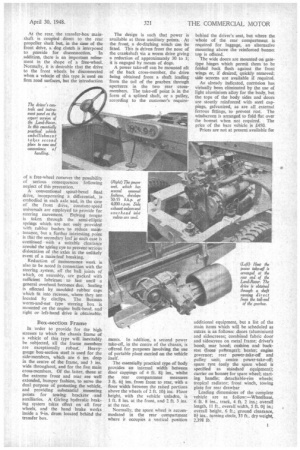At the rear, the transfer-box mainshaft is coupled direct to
Page 47

If you've noticed an error in this article please click here to report it so we can fix it.
the rear propeller shaft. but,,, in the case of the front drive, a dog clutch is interposed tot provide for disconnection. in addition, there is an important refinement in the shape of a free-wheel. Normally, it is desirable that the drive to the front wheels be disconnected when a vehicle of this type is used on firm road surfaces but the introduction of a free-wheel removes the possibility of serious consequences following neglect of this precaution.
A conventional spiral-bevel finak drive, incorporating a differential, is embodied in each axle and, in the case of the front drive, constant-speed universals are employed to provide for steering movement. Driving torque is taken through the semi-elliptic springs which are not only provided with rubber bushes, to reduce maintenance, but a further interesting point is that the secondary leaf in eaCh case is continued with a suitable clearance around the spring eye to prevent serious dislocation of the axles in the unlikely event of a main-leaf breaking. Reduction of maintenance work is also to be noted in connection with the steering system, all the bail joints of which, on assembly, are packed with sufficient lubricant to last until a general overhaul becomes due. Sealing is effected by moulded rubber caps which fit into recesses, where they are located by circlips. The Burman worm-and-nut type steering box is mounted on the engine bulk-head, and right or left-band drive is obtainabte.
Box-section Frame
In order to provide for the high stresses to which the chassis frame of a vehicle of this type wilt inevitably be subjected, all the frame members are exceptionally robust. Heavygauge box-section steel is used for the side-members, which are 6 ins. deep in the centre of the frame, and 3 ins. wide throughout, and for the five main cross-members. Of the latter, those at the extreme front and rear are well extended, bumper fashion, to serve the dual purpose of protecting the vehicle, and providing substantial mounting points for towing bracketsand auxiliaries. A Girling hydraulic braking system takes effect on all four wheels, and the hand brake works inside a 9-in, drum located behind the transfer box. The design is such that power is available at three auxiliary points. At the front, a de-ditching winch can be fitted. This is driven from the nose of the crankshaft via a worm drive giving a reduction of approximately 30 to 1; it is engaged by means of dogs.
A power take-off can be mounted aft of the back cross-member, the drive being obtained from a shaft leading from the tail of the gearbox through pPrtures in the two rear crossmembers. The take-off point is in the form of a splined shaft, or a pulley, according to the customer's require
ments. In addition, a second power take-off, in the centre of the chassis, is offered for purposes involving the use of portable plant carried on the vehicle itself.
The essentially practical type of body provides an internal width between door cappings of 4 ft. ai ins., whilst the rear compartment measures 3 ft. 6t ins, from front tn rear, with a floor width between the raised portions above the wheels of 2 ft, 104 ins. Floor height, with the vehicle unladen, is 1 ft. 8 ins, at the front, and 2 ft. 3 ins. at the rear.
Normally, the spare wheel is accommodated in the rear compartment where it occupies a vertical position behind the driver's seat, but where the whole of the rear compartment is required for luggage, an alternative mounting above the reinforced bonnet top is offered.
The wide doors are mounted on gitetype hinges which permit them to he folded back flush against the front wings or, if desired, quickly removed; side screens are available if required.
As already indicated, corrosion has virtually been eliminated by the use of light aluminium alloy for the body, but the tops of the body sides and doors are stoutly reinforced with steel cappings galvanized, as are all external ferrous fittings, to prevent rust. The windscreen is arranged to fold flat over the bonnet when not required. The price of the bare vehicle is £450.
Prices are not at present available for
additional equipment, but a list of the main items which will be scheduled as emtras is as follows: doors (aluminium) and sidescreens; combined fabric door and sidescreen on metal frame; driver's hood; rear hood; cushion and backrest (front palsenger); heater; engine governor; rear power-take-off and pulley unit; centre power-take-off; spare tyre (only the spare wheel is specified as standard equipment); carrier on bonnet for spare wheel; starting. handle; detachable-rim wheels; tropical radiator: front winch, towing plate for rear drawbar
Leading dimensions of the complete vehicle are as follow:—Wheelbase, 6 ft_ 8 ins., track, 4 ft. 2 ins.. overall length, 11 ft., overall width, 5 it. 04 in.; overall height, 6 ft.; ground clearance, 8* ins.. turning circle, 33 ft., dry weight, 2,398 lb.




































































































































































